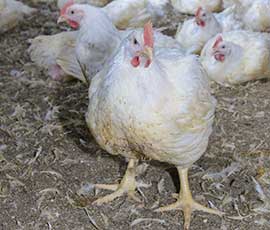Livestock strain of MRSA found on poultry farm

Livestock-associated MRSA bacteria have been found on a poultry farm in East Anglia, the AHVLA has confirmed.
The presence of the bacteria was picked up during surveillance on the farm by AHVLA on behalf of the Veterinary Medicines Directorate. While the infection is not considered to represent a significant risk to bird health and welfare, the farm in question will be subject to further inspections.
“Once the poultry have been slaughtered and sold, the owner will carry out cleansing and disinfection of their accommodation to ensure the next birds do not become colonised when they arrive on site,” said an AHVLA statement. “The AHVLA will revisit the farm after depopulation to determine whether LA-MRSA is still present.”
LA-MRSA is not the same bacteria as those that cause the healthcare-associated infections affecting people.
“Any risk of contracting MRSA through meat from animals with these bacteria is very low when usual good hygiene and thorough cooking practices are observed,” said Steve Wearne, director of policy at the Food Standards Agency. “All poultry should be handled hygienically and cooked thoroughly to destroy any bacteria that may be present.”
This strain of bacteria is relatively widespread in livestock in Europe, especially in pigs, including countries from which meat is regularly sourced by the UK.
Gary Ford, chief poultry adviser for the NFU, welcomed chief medical officer Dame Sally Davies’s assurance to the public that the meat was safe to eat.
“While this is the first time this particular animal strain of MRSA has been found in Britain, it is relatively widespread in continental Europe, and there are no known cases of people contracting MRSA from eating meat,” he said.
“Consumers can be reassured, therefore, that the risk to human health is extremely low. The usual good hygiene practices should be observed – all poultry should be handled properly and cooking thoroughly will destroy any bacteria that may be present.”
LA-MRSA rarely causes disease in people and in most cases the bacteria clear within 24 hours. It can potentially pass from animals to humans through direct contact or through dust in animal housing and is therefore primarily an occupational risk for those in contact with affected livestock.
